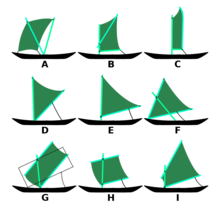
Back Proa German Prao Spanish Prao French Proa Hungarian Prahos Italian Proa NB Proa Polish Проа Russian Prao Slovak Proa Swedish



A: Double sprit (Sri Lanka)
B: Common sprit (Philippines)
C: Oceanic sprit (Tahiti)
D: Oceanic sprit (Marquesas)
E: Oceanic sprit (Philippines)
F: Crane sprit (Marshall Islands)
G: Rectangular boom lug (Maluku Islands)
H: Square boom lug (Gulf of Thailand)
I: Trapezial boom lug (Vietnam)
Proas are various types of multi-hull outrigger sailboats of the Austronesian peoples. The terms were used for native Austronesian ships in European records during the Colonial era indiscriminately, and thus can confusingly refer to the double-ended single-outrigger boats of Oceania, the double-outrigger boats of Island Southeast Asia, and sometimes ships with no outriggers or sails at all.
In its most common usage, the term proa refers to the Pacific proas which consist of two (usually) unequal-length parallel hulls. It is sailed so that one hull is kept to windward, and the other to leeward. It is double-ended, since it needs to "shunt" to reverse direction when tacking. It is most famously used for the sakman ships of the Chamorro people of the Northern Marianas, which were known as the "flying proas" for their remarkable speed.[2]
In Island Southeast Asia, the term proa may also sometimes be used, but the terms perahu, prau, prahu, paraw and prow are more common. These differ from the Pacific proas in that they are not double-ended and have a trimaran configuration with two outriggers. These are widely used in the native ships of Indonesia, Malaysia, and the Philippines, and continue to be used today as traditional fishing, cargo, and transport vessels.
Proas are traditionally rigged with the crab claw and tanja sails. The modern proa exists in a wide variety of forms, from the traditional archetype still common in areas described, to high-technology interpretations specifically designed for breaking speed-sailing records.
- ^ Doran, Edwin B. (1981). Wangka: Austronesian Canoe Origins. Texas A&M University Press. ISBN 9780890961070.
- ^ Folkard, Henry Coleman (1853). The Sailing Boat: a description of English and foreign boats. London: Hunt and Son.
© MMXXIII Rich X Search. We shall prevail. All rights reserved. Rich X Search